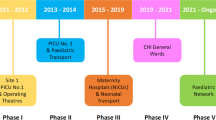Abstract
Purpose
To compare the concentration conformity of infusion solutions manually prepared on intensive care units (ICU) with solutions from pharmacy-based, automated production.
Methods
A prospective observational study conducted in a university hospital in Germany. Drug concentrations of 100 standardised infusion solutions manually prepared in the ICU and 100 matching solutions from automated production containing amiodarone, noradrenaline or hydrocortisone were measured by high-performance liquid chromatography analysis. Deviations from stated concentrations were calculated, and the quality of achieved concentration conformity of the two production methods was compared.
Results
Actual concentrations of 53% of the manually prepared and 16% of the machine-made solutions deviated by >5% above or below the stated concentration. A deviation of >10% was measured in 22% of the manually prepared samples and in 5% of samples from automated production. Of the manually prepared solutions, 15% deviated by >15% above or below the intended concentration. The mean concentration of the manually prepared solutions was 97.2% (SD 12.7%, range 45–129%) and of the machine-made solutions was 101.1% (SD 4.3%, range 90–114%) of the target concentration (p < 0.01).
Conclusions
In this preliminary study, ward-based, manually prepared infusion solutions showed clinically relevant deviations in concentration conformity significantly more often than pharmacy-prepared, machine-made solutions. Centralised, automated preparation of standardised infusion solutions may be an effective means to reduce this type of medication error. Further confirmatory studies in larger settings and under conditions of routine automated production are required.

Similar content being viewed by others
References
Calabrese AD, Erstad BL, Brandl K, Barletta JF, Kane SL, Sherman DS (2001) Medication administration errors in adult patients in the ICU. Intensive Care Med 27:1592–1598
Rothschild JM, Landrigan CP, Cronin JW, Kaushal R, Lockley SW, Burdick E, Stone PH, Lilly CM, Katz JT, Czeisler CA, Bates DW (2005) The Critical Care Safety Study: the incidence and nature of adverse events and serious medical errors in intensive care. Crit Care Med 33:1694–1700
Valentin A, Capuzzo M, Guidet B, Moreno RP, Dolanski L, Bauer P, Metnitz PG (2006) Patient safety in intensive care: results from the multinational Sentinel Events Evaluation (SEE) study. Intensive Care Med 32:1591–1598
Garrouste-Orgeas M, Timsit JF, Vesin A, Schwebel C, Arnodo P, Lefrant JY, Souweine B, Tabah A, Charpentier J, Gontier O, Fieux F, Mourvillier B, Troché G, Reignier J, Dumay MF, Azoulay E, Reignier B, Carlet J, Soufir L (2010) Selected medical errors in the intensive care unit: results of the IATROREF study: parts I and II. Am J Respir Crit Care Med 181:134–142
Valentin A, Capuzzo M, Guidet B, Moreno R, Metnitz B, Bauer P, Metnitz PG (2009) Errors in administration of parenteral drugs in intensive care units: multinational prospective study. BMJ 338:b814
Burmester MK, Dionne R, Thiagarajan RR, Laussen PC (2008) Interventions to reduce medication prescribing errors in a paediatric cardiac intensive care unit. Intensive Care Med 34:1083–1090
Tissot E, Cornette C, Demoly P, Jacquet M, Barale F, Capellier G (1999) Medication errors at the administration stage in an intensive care unit. Intensive Care Med 25:353–359
Fraind DB, Slagle JM, Tubbesing VA, Hughes SA, Weinger MB (2002) Reengineering intravenous drug and fluid administration processes in the operating room: step one: task analysis of existing processes. Anesthesiology 97:139–147
Fahimi F, Ariapanah P, Faizi M, Shafaghi B, Namdar R, Ardakani MT (2008) Errors in preparation and administration of intravenous medications in the intensive care unit of a teaching hospital an observational study. Aust Crit Care 2:110–116
Ferner RE, Langford NJ, Anton C, Hutchings A, Bateman DN, Routledge PA (2001) Random and systematic medication errors in routine clinical practice: a multicenter study of infusions, using acetylcysteine as an example. Br J Clin Pharmacol 52:573–577
Garnerin P, Pellet-Meier B, Chopard P, Perneger T, Bonnabry P (2007) Measuring human-error probabilities in drug preparation: a pilot simulation study. Eur J Clin Pharmacol 63:769–776
Parshuram CS, To T, Seto W, Trope A, Koren G, Laupacis A (2008) Systematic evaluation of errors occurring during the preparation of intravenous medication. CMAJ 178:42–48
Ferner RE (2009) The epidemiology of medication errors: the methodological difficulties. Br J Clin Pharmacol 67:614–620
Allen EM, Van Boerum DH, Olsen AF, Dean JM (1995) Difference between the measured and ordered dose of catecholamine infusions. Ann Pharmacother 29:1095–1100
Parshuram CS, Ng GY, Ho TK, Klein J, Moore AM, Bohn D, Koren G (2003) Discrepancies between ordered and delivered concentrations of opiate infusions in critical care. Crit Care Med 31:2483–2487
Wheeler DW, Degnan BA, Sehmi JS, Burnstein RM, Menon DK, Gupta AK (2008) Variability in the concentrations of intravenous drug infusions prepared in a critical care unit. Intensive Care Med 34:1441–1447
Hassan E, Badawi O, Weber RJ, Cohen H (2010) Using technology to prevent adverse drug events in the ICU. Crit Care Med 38:S97–S105
The Audit Commission (2001) A spoon full of sugar—medicines management in NHS hospitals. Audit Commission Publications, London, pp 1–79
Hartwick RA, Brown PR (1980) The use of high pressure liquid chromatography in clinical chemistry and biomedical research. Adv Clin Chem 21:25–99
Franklin BD, Taxis K, Barber N (2009) Parenteral drug errors. Reported error rates are likely to be underestimation. BMJ 338:b1814
Eckmanns T, Bessert J, Behnke M, Gastmeier P, Ruden H (2006) Compliance with antiseptic hand rub use in intensive care units: the Hawthorne effect. Infect Control Hosp Epidemiol 27:931–934
Moyen E, Camire E, Stelfox HAT (2008) Clinical review: medication errors in critical care. Crit Care 12:208
Acknowledgments
This study was investigator initiated and funded by the Pharmacy of the University Medical Center Hamburg-Eppendorf. No other sponsoring was obtained.
Conflict of interest
None.
Author information
Authors and Affiliations
Corresponding author
Additional information
C. Dehmel and S. A. Braune contributed equally to this article.
D.C. Dartsch and S. Kluge conceived the study equally as senior authors.
Rights and permissions
About this article
Cite this article
Dehmel, C., Braune, S.A., Kreymann, G. et al. Do centrally pre-prepared solutions achieve more reliable drug concentrations than solutions prepared on the ward?. Intensive Care Med 37, 1311–1316 (2011). https://doi.org/10.1007/s00134-011-2230-4
Received:
Accepted:
Published:
Issue Date:
DOI: https://doi.org/10.1007/s00134-011-2230-4




